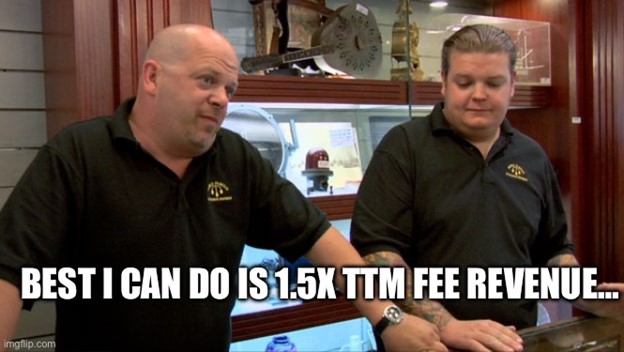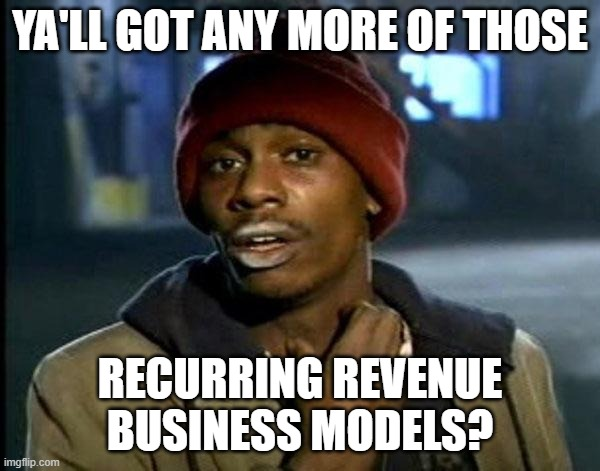As the owner of a hedge fund business (defined as a management company and incentive fees received though an affiliated entity), I’m always amazed at the returns on capital in the business. Excluding the first start-up year, the business has annually earned many times the total capital initially invested, and only requires rather minimal working capital to sustain it. As an enterprise, it has one of the best ROIC metrics of any businesses I have ever analyzed.
So, what would Wall Street pay for such an amazing business?? I’m guessing that it would be a surprisingly low multiple on earnings, and this realization led me to write this piece.

You see, despite having run this business for its fifth year now, I have zero visibility into the earnings of the business. Zero. The business basically breaks even on management fees, though we do have some flexibility in our spending. However, most of the economics are in the incentive allocation, and I have no way to predict what that incentive allocation will look like. Even worse, in some years, there will not be any incentive allocation as the fund will have negative performance. If I cannot predict results and give guidance, how can I ever expect Wall Street to value the business, as they’re one step removed from my predictive ability as the owner of the business??
If my hedge fund business were publicly traded, I feel that it would likely trade for little more than its tangible book value, or some low multiple on assets under management. Which seems like an odd valuation, as I believe that my business has a surprisingly large quantum of intangible value, hence why it has produced such strong earnings since inception. In any case, this is a somewhat long-winded way of saying that; Wall Street tends to dramatically over-value a stable and growing earnings stream, and refuses to value unpredictable earnings, even at businesses that have historically had high returns on capital.
Honestly, I find this phenomenon to be quite odd and despite over two decades of investing experience, I still cannot comprehend why this opportunity exists. As a result, I frequently discover highly undervalued businesses that are of an unusually good quality, yet the market has ignored them as they cannot model the earnings. Here’s the honest truth; not all businesses are of a SAAS nature with recurring revenues. Many businesses are just as good, or even better over rolling five-year periods, but the earnings are all over the place, frequently with periods of losses as well.

I feel that before the year 2000, investors would look at these businesses and treasure them for their high ROIC over multi-year periods, and simply ignore the quarterly volatility. However, as the time duration of most investor expectations has truncated, so too has the valuation of those companies that have become harder to model on a quarterly basis.
At my fund, we call these things “zero visibility businesses.” We don’t mean this in a pejorative sense. Instead, we mean this in the factual sense. It’s simply impossible to predict the quarterly results and as a result, we’re likely getting a bargain—frequently an unusually good bargain.
So then, how do you put a valuation on something where the numbers are all over the place? Now, this is the real challenge. To be honest, sometimes we simply cannot put a value on such a business. We can look at historical margins, or returns on capital over long periods of time, and try to back into a stabilized level of earnings for the business, but often, this exercise leaves us with a false sense of precision. Instead, we simply eyeball the thing—does the price seem too cheap for what it is?? I realize that this is highly unscientific, but by the time you get to the spreadsheet and try to model one of these businesses, you’ve already lost the narrative. I’m from the school of investing where it’s either painfully obvious that I’m getting a bargain, or it’s in the “too hard pile.”
The corollary to this practice is that I’m investing on only a slightly higher plane than many other investors who also demand a better discount in terms of valuation for something that has erratic earnings.
So then, if an entrepreneurial investor like me won’t be the one closing the gap to fair value, and most other investors refuse to even contemplate a business without quarterly visibility, what makes these companies ever re-value?? In my experience, only two things will do it. One is continuous buybacks. If one of these businesses shrinks the share-count in an aggressive manner, eventually it will re-rate as a growth stock, just because the earnings per share are growing, even if the earnings themselves are erratic. The other outcome is that a strategic or financial buyer covets the asset. This is obviously far less desirable, as the premium offered is frequently insufficient, and they effectively steal the asset from me. Long-term readers of mine know that this has been a recurring bane of mine as a value investor, but such is life.
I do think it’s worth re-examining the buyback potential of these businesses. I believe most buybacks that are executed today are wasteful of capital. They’re often done at egregious valuations and are a form of financial engineering, designed to allow insiders to monetize their stock options or to offset excessively dilutive stock-based compensation. The flip side of this, is that if you buy back your shares at a large discount to fair value, as in the case of one of these “zero visibility businesses,” and take advantage of the stupidity of the market, then you’re likely creating substantial shareholder value—especially if you continue the buyback every quarter. Many of the companies that we own are executing such a plan, and while it may not immediately lead to share price performance, I am convinced that they are spring-loading the share price for the next upswing in the business.
In summary, I’m always focused on where the opportunity is. I’m genuinely surprised at the bargains that exist in places where the earnings are hard to predict, and I suspect that this segment of the market will only become more attractive as capital continues to congregate to the few sectors that show linear growth.
As a result, you can likely guess where I’m spending my research energy.



The Great Rotation…